On the wild side in the Amazon
Nothing triggers a traveller’s primal instincts like the world’s largest tropical rainforest.
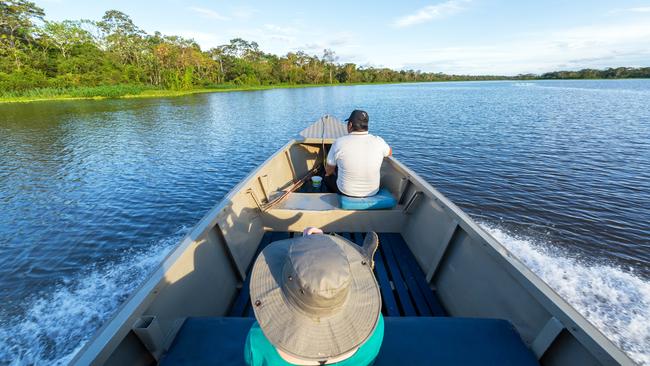
Of all Earth’s remote and daunting landscapes, forests are the wildest. I’ve seen the icy barrens of Antarctica and the Sahara’s shifting dunes but nothing triggers my primal instincts like the timeless magic of trees. Forests are freedom. The Amazon is the world’s largest rainforest, covering 5.5 million square kilometres of South America’s northern reaches from Bolivia to Brazil, Venezuela to Suriname. It is watered by the world’s mightiest river, which springs high in the Peruvian Andes and flows more than 6000km across the continent to empty into the Atlantic.
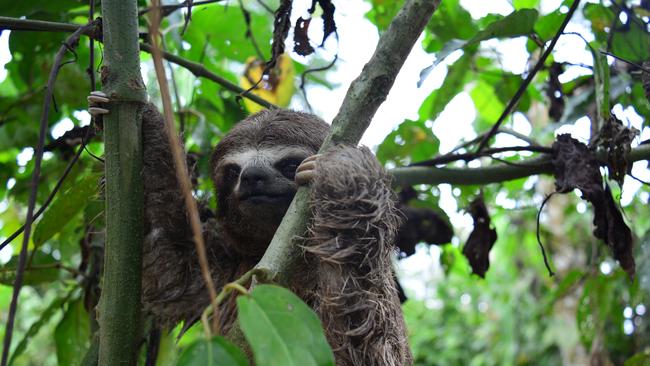
The gateway to the Peruvian Amazon is Iquitos, a sultry, haphazard city of about 500,000 residents. The only way in is by air or river, yet it is one of the easiest access points to this rare wilderness. Coming in to land from Lima, there is only jungle and water visible to the horizon. The few roads peter out after no distance at all. It is isolation on the grandest scale imaginable. I’ve visited Iquitos twice, in the dry season (May-October) and once at the end of the wet, when river levels can rise between 10m and 13m. I prefer it in flood, when the Amazon basin becomes a jungle of mirrors; rickety wooden houses seem to float and a slow boat ride reveals vignettes of life among the riberenos, the river people.
A girl in a navy singlet and beige pedal-pushers dangles a silver catfish at the end of a handline. Three dugouts approach our motorboat cautiously; a boy in one produces a speckled caiman for us to admire and photograph (for a fee, naturally). At Puerto Miguel village, we arrive just in time to witness schoolchildren tie up their rowboats and trot off to class along wooden planks laid over a field of sucking mud. We walk the planks too, to the home of Meliton Fababa, an artist who supplements his income by hosting foreigners from the luxury river cruisers that ply these waters. We sit down to breakfast in his stilted house, and are served bacon and egg cassava-bread rolls, chocolate muffins and filter coffee. Chickens peck the floorboards for crumbs. Fababa’s shy daughter emerges to stare at us before fleeing back to the safety of her mother in the kitchen.
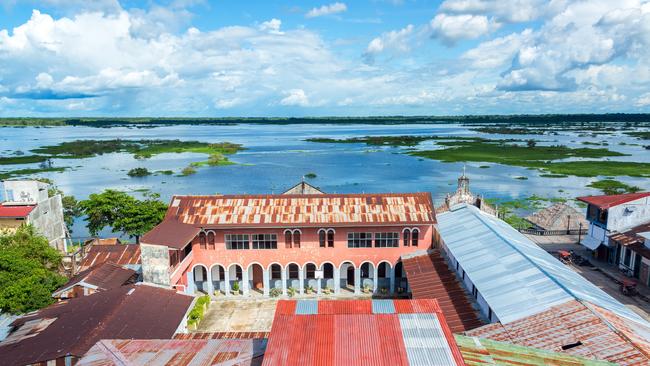
On another outing to Casual village, a machete-wielding man named Federico leads me on a sweaty, stinging walk through his jungly backyard to meet the neighbours. He produces a miniature poison-dart frog, one of the most toxic creatures on the planet, its stomach enamelled in intricate patterns. He plucks a pink-toed tarantula out of the leaf litter and urges me to hold it. The fluffy pink toes feel like cotton buds as they tap their way over my hands and up my sleeve. Later, because I joke that I won’t leave his jungle until I’ve seen the largest snake on Earth, Federico finds a writhing anaconda on a sapling. It’s only juvenile but menacing, nonetheless.
The Amazon rainforest is so unfamiliar to outsiders it’s essential to have a mentor on hand to interpret the unknown. Mine is Sandro Soria del Aguilar, born and raised in the village of Nueva Jerusalen on a remote tributary about 20 hours by river from Iquitos. Most visitors to the Peruvian Amazon spend their time exploring Pacaya-Samiria, a national reserve named for the rivers that meet here, just two of the 1000 or so tributaries of the Amazon. It has a population of about 50,000, mainly Cocama Indians. But there are also Shipibos, regarded as the best shamans for their mastery of healing plants. And Yaguas, the masters of curare, which is extracted from jungle vines and used as an anaesthetic but, mixed with poison frog venom, becomes a deadly weapon.
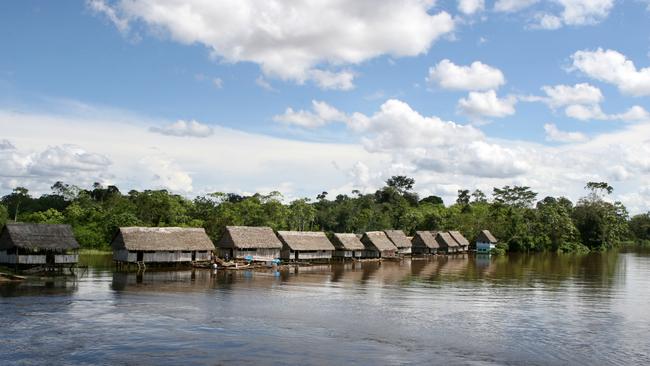
Growing up, del Aguilar’s uncle taught him the calls of the wild. His skills come in handy on twice-daily river safaris where he reveals himself as the Dr Dolittle of the Amazon, coaxing all manner of animals from the jungle. He banters with Drink-Your-Beer birds (named for their distinctive three-tone cry), squirrel monkeys and howler monkeys. He makes a puffy, quacky noise like Donald Duck and suddenly pink river dolphins are tracing arcs around our boat.
Sandro’s surname, Aguilar, means eagle in Spanish. “Hence the eyes,” he smiles. His superhuman vision can spot a great potoo camouflaged in a tree from 100m. “It looks like a sheep on a branch,” cries one of our group. More like a fat tawny frogmouth to me, but either way it’s a bizarre bird.
Elsewhere in the monochrome forest he spies a dusky titi monkey chilling solo on a branch. A horned screamer takes flight in a flap of legs and wings. We cruise through a watery field of giant victoria amazonica lilies, their pads the size and shape of paella pans. Even more remarkable, Del Aguilar says the lily flowers change sex overnight and trap beetles for 24 hours to transfer the male pollen to the female flower.
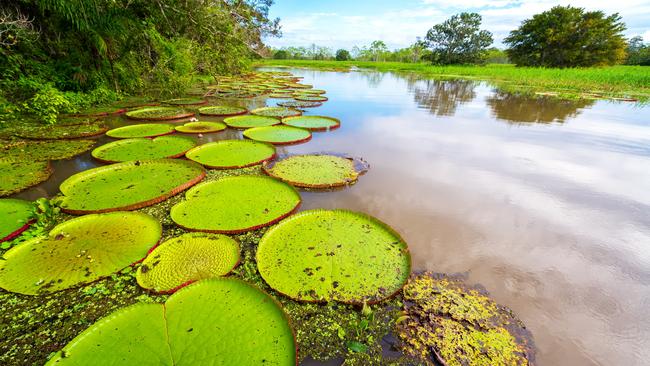
There is no official collective noun for sloths because they are solitary creatures. But I’m convinced there should be. A coma of sloths? A torpor? Our first three-toed exhibit is a stationary blob at the top of a towering cecropia, or trumpet tree. Our second looks surprisingly nimble as it climbs, slowly but surely, to the top of another cecropia. A third sloth dangles upside down from a monkey-bar branch. Still another eyes us coolly while munching scarlet kapok flowers. Del Aguilar explains that sloths can rotate their heads 270 degrees, like an owl, which is handy when keeping watch for harpy eagles, their main predators. The eagles have a particularly gruesome way of hunting sloths and monkeys — they crush the prey’s skulls with their talons. Fortunately for sloths, humans avoid them. The riberenos people believe the meat makes them ill; another superstition warns pregnant women who see one will give birth to a sloth-faced child, which would be most unfortunate.
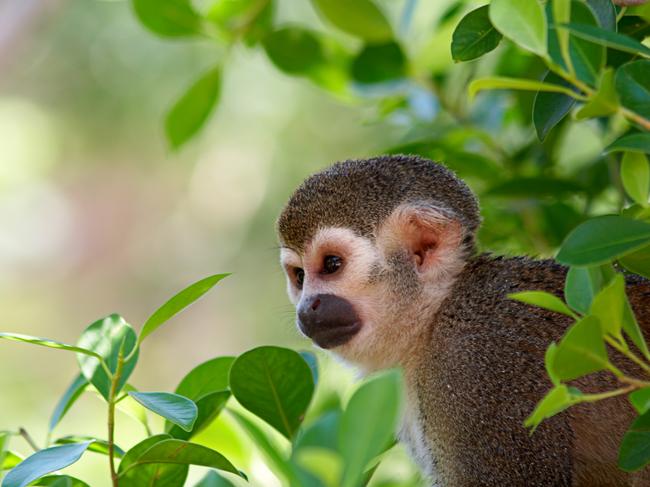
For all the awesome animals, it’s humans who leave the deepest impression on the Amazon. One afternoon we motor to placid Lake Clavero, drop anchor, and wait. “The children are going to be very excited when they see you,” our naturalist guide Julio Mozambite grins. Soon enough a flotilla of dugouts launches from the far bank, small figures clambering aboard and paddling madly towards our skiff. The village children hold back until our guide shouts “Quereis nadar?” (Do you want to swim?) and then the water froths with tiny limbs racing towards us. They launch themselves off our bow with gleeful shrieks and, in the water, use my shoulders as a diving board or harass me to toss them high into the air. The younger ones swim up close and giggle in, or perhaps at, my face. For now, while exploring the world remains a far-off dream and I wonder if I’ll ever see the Amazon again, these remembered moments of joy are more vivid than ever.
In the know
High water season in the Western Amazon (December-April) means limited land exploration but access to more remote tributaries. Low water from
May/June-November offers greater land options but higher temperatures. It’s usual to see much more wildlife in wet than dry season. The most comfortable touring options are luxury expedition boats run by Aqua Expeditions and Delfin, with multi-night itineraries all year.
Commuter ferries operated by Consorcio Fluvial del Amazonas offer day and overnight journeys ex-Iquitos, with guests based at jungle lodges for land and water explorations. It’s also possible to take the ferry all the way from Iquitos to Santa Caterina at the Brazilian border.

To join the conversation, please log in. Don't have an account? Register
Join the conversation, you are commenting as Logout